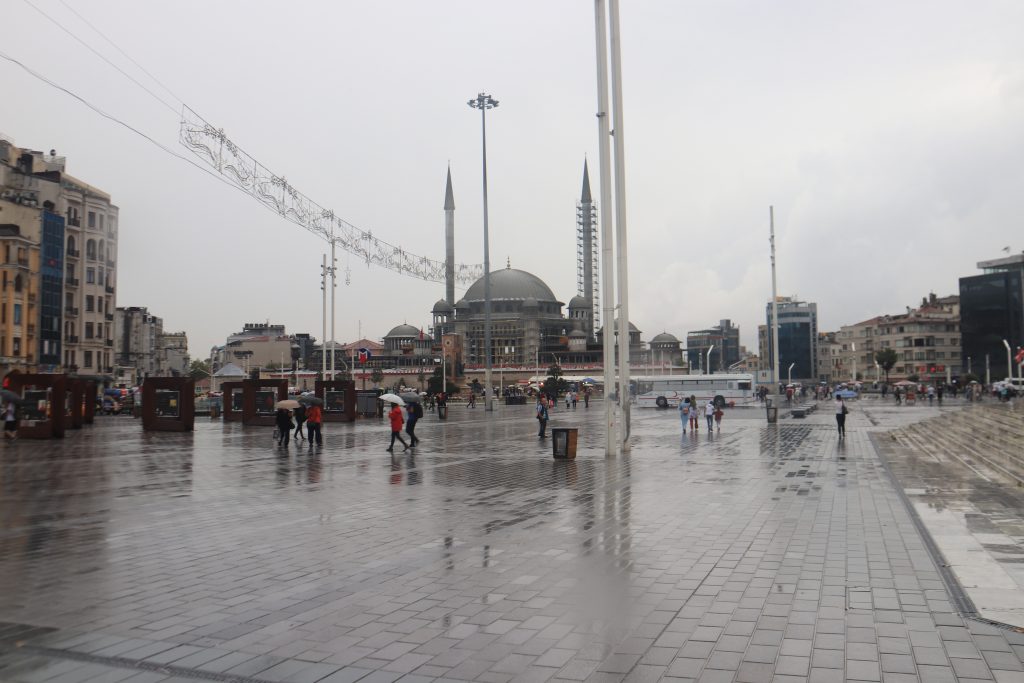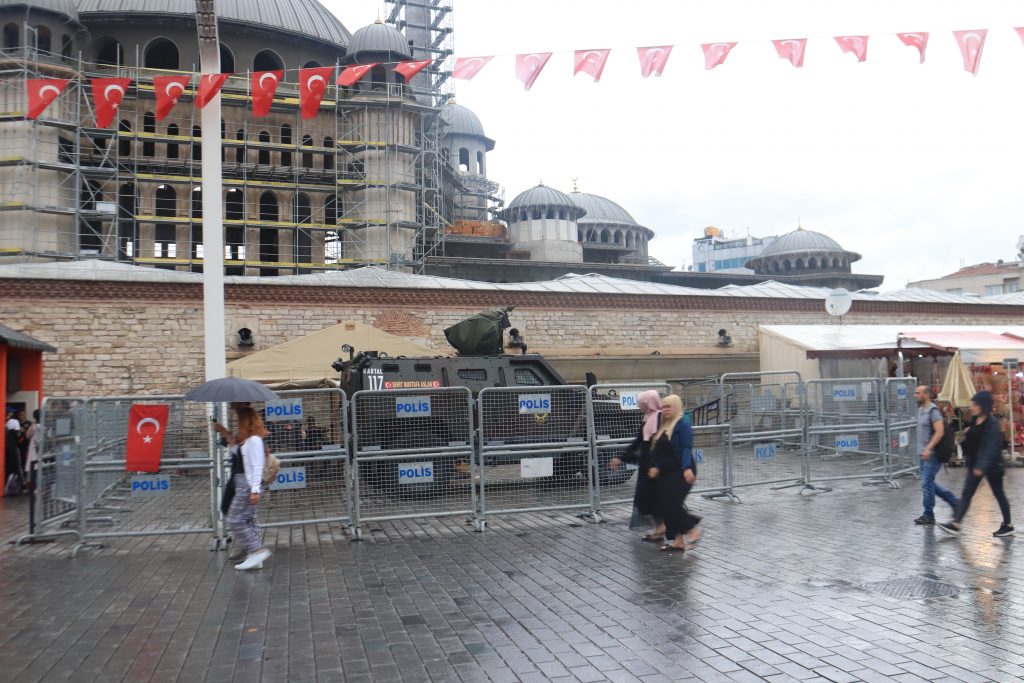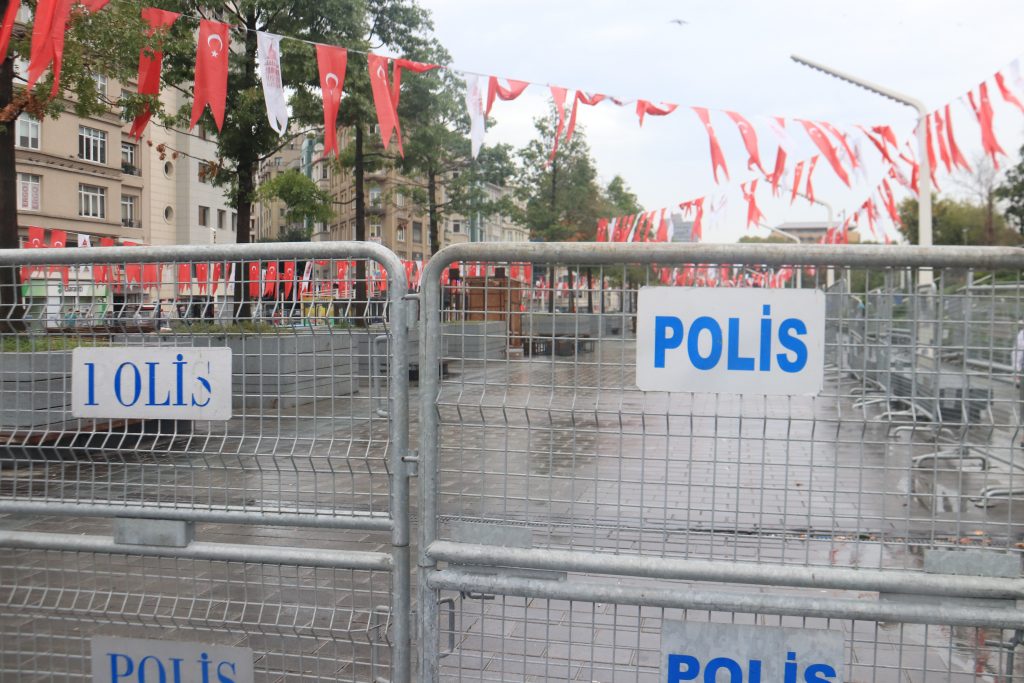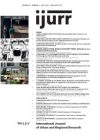The global rise of popular right-wing regimes has polarized states and cities by curtailing and violating freedoms and rights. Despite the prominence of the impact of populism[1] on cities, however, there has not been a thorough examination of the interaction between populism and urban space. The issue is complicated as well as vast with its global impact. On the one hand, global cities have taken major blows from authoritarian populist policies, including but not limited to increasing security measures, imposition of exclusionary anti-immigrant politics, aggressive neoliberal agendas and the erosion of democratic liberties. On the other hand, however, the metropolitan city has come to the forefront of resistance against populist regimes. Globally, we have witnessed wide-ranging forms of urban protest manifested as urban social movements, occupation of public spaces and urban insurgency (Dikec 2017; Dikec and Swyngedouw 2017). Moreover, local municipal politics and urban space have taken on new roles in what we used to consider as nation-states’ functions, such as immigration, integration and securitization (Mullenkopf and Pasteur 2016; Gluck and Low 2017).
Similar to many global cities across the world, Istanbul fell into the heart of the enigma of populism under the reign of Recep Tayyip Erdogan, Turkey’s former Prime Minister (2002-2014), current President of Turkey (2014-present). What has Tayyip Erdogan’s right-wing populist ascendancy done to Istanbul? In which ways was Istanbul affected by Erdogan’s rule –a city that hosted multiple civilizations, ethnicities and religions, and bridged Western and Muslim cultures throughout its rich history? For centuries, different civilizations and political forces fought over the ownership of Istanbul—Ottomans versus Byzantium, the secularists versus Islamists, and most recently democrats versus the right-wing populists, to mention a few. Hence, it has historically been a contested city divided by socio-political rifts as well as by physical fault-lines, particularly the Bosphorus channel that marks the border between Europe and Asia.

Taksim Square. Photo: Burak Işyar, 2019.
Istanbul: A Hostage to Two Decades of Populist Hegemony
Mr. Erdogan’s political career had taken off when he was elected as the mayor of Istanbul metropolitan in 1994. His first political victory in local elections shook up not only the “secularist” residents of Istanbul but many others in the rest of Turkey, who were intimidated by the rise of political Islam in the secular Republic of Turkey. Unlike some other cities that were clearly identified with a strong hold of Islamism or secularism since the late 1990s, this cultural, economic and socio-political hub of Turkey became difficult to share between the supporters and opponents of Erdogan’s Justice and Development Party (JDP).
Despite successive electoral victories since 2002, Erdogan’s populist hegemony failed to achieve total control of Istanbul. Claiming to represent the real Muslim people who were “left behind” as opposed to the Westernized elite, the regime has had issues and encroached upon liberal lifestyles, vibrant night life, music halls and other venues where Western arts were performed as well as historic and iconic places that represented the diverse mixed culture and history of Istanbul. Monumental icons of secular Westernized Turkey were attacked by the regime, and demolished one by one, such as the Ataturk Kultur Merkezi, Istanbul’s major music hall in Taksim. The demolition of these places to which Istanbulites have strong emotional attachment antagonized and infuriated the urbanites. The increasingly frustrated opposition retreated to their Istanbul neighborhoods, such as Moda, Tesvikiye, Etiler, Ulus and Kadikoy. These urban cocoons helped Erdogan’s opposition to maintain a sense of freedom and control exercised in their everyday life. In my article in a former IJURR volume (Turam 2013), I argued that urban ways of life were resilient in their struggle against the reversal of democracy, even when other formal channels of political resistance were repressed and failed. To the extent Istanbulites managed to territorialize their immediate urban environment and live in these “islands of freedom,” they continued to maintain some sense of autonomy and leeway in the face of overwhelming populist authoritarianism. Even in the darkest moments of Erdogan’s political repression in the post-Gezi period, the continuity and flow of everyday life in Istanbul surprised many visitors from Western countries, who on their return observed to me: “Everything looked ‘normal’ in Istanbul.”
When the Gezi protest erupted in Taksim-Istanbul in 2013, it demonstrated the culmination of a new urbanism that was able to rise above the political polarization in its claim for democratic freedoms for all. Put differently, Gezi protestors were able to bridge historically antagonistic groups across the great divide. The Gezi uprising united all in the defense of rights of all rather than one’s own identity group or ideological partisanship. Through the Gezi protests, the demonstrators and their supporters in the city spoke so bold for democratic freedoms and so loud against the violation of rights that the regime became deeply threatened and intimidated. Not only was the Gezi protest crushed brutally, but Erdogan’s political rule also took a much more repressive tone since the non-violent uprisings, which he later attacked as another “coup attempt.”
Since the violent repression of the Gezi protests, Taksim square in the heart of Istanbul’s downtown has been transformed dramatically. Large numbers of police and security forces took a hold of the square in order to establish a preemptive defeat of potential protests. Taksim square epitomizes the securitized urban space, which used to be the hub of democratic contestation. Along with intense securitization, the built environment of the square also changed radically. The stone pavements that some Gezi protestors had pulled out to create barricades were replaced by a seamless and esthetically insufferable asphalt concrete. A new mosque was built in the center of the square, despite being a part of the city historically identified with multiple ethnicities and religions of Istanbul’s diverse minorities. By using the populists’ typical excuse of security, the JDP kept hitting at Istanbul’s cosmopolitan, liberal and avant-garde faces. The city turned into the major battle ground between the old-timer Istanbulites and the new populist political power holders. As my fieldwork in the post-Gezi period in Istanbul suggested, Istanbul’s residents felt less safe and more fearful in their own city which was increasingly securitized and controlled by the riot police.

Mosque and police in Taksim-securitized zone. Photo: Burak Işyar, 2019.
It is important to note however that the dark shadow of populism obscures the new emboldening and emancipating role that metropolitan cities have taken on. Across academic disciplines, cities have been at the center of research on socio-economic inequalities, neoliberalism, socio-spatial segregation, gentrification and so on. But since Weber’s master piece, The City, urban space never received the much deserved attention for its capacity to empower and liberate people and societies. In which ways do cities shape the experience of democratic liberties and rights under the reign of populist regimes? With this question in mind, my research spatialized democratic contestation over liberties and rights. When populist political rules target and encroach urban movements, crash protests and undermine collective action, the city still persists as a shield. The resilience of the city continues to flourish at the intersection of socio-spatial and political aspects of mundane everyday life. Accordingly, a major key for the defense of democracy against repressive populism lies in the ways urbanites live, feel, act and react in their intimate daily environment. As this urbanity remains beyond collective action, it is beyond the reach of police brutality to attack and erase multiple facets of urban life.
The Agentic City: Istanbul Strikes Back
When all branches of the state have become either weakened and muted and media outlets are coopted by populist authoritarianism; when the ruling party in Turkey was identified as the party of the President; when judicial activism gave in to the power of Erdogan’s one-man-rule, and when the once-upon-a-time powerful Turkish military was stripped of its former leverage, the city has persisted as the bulwark of democratic resilience (Turam 2015). Hence, it is not surprising that Erdogan’s first political blow came from the big cities, as his party lost municipal elections including, but not limited to, Ankara (capital city), Izmir (secularists stronghold), Adana, Antalya, Istanbul.
Istanbul is not like any other city in Turkey. It is the heart of Turkey’s economic, social and political power. While being the financial hub as well as the main economic source for JDP’s opportunist rentier logic of endless constructions, it is also the home for the intellectual elite and the art community. The city hosts the country’s competitive educational institutions, many of which are recognized internationally. Unlike the land-locked capital city Ankara, Istanbul surrounded by two seas and a channel is linked to international networks and collaborations. The geo-political and social connectedness renders Istanbul a capital of knowledge production, art, fashion and industry. Hence, Istanbul’s distinction as a city in Turkey and the world is not only socially and historically constructed, but is also shaped by physical, material facts and geo-political circumstances. The culmination of these characteristics endows Istanbul with capacities and skills to generate remarkable resilience and power.

Taksim square, a securitized space. Photo: Burak Işyar, 2019.
Ekrem Imamoğlu from the main opposition party, Republican People’s Party, defeated JDP with a narrow margin in municipal elections on March 31 2019. As experienced in other populist regimes, the JDP government objected the electoral results by continuing to aggravate and polarize the society. After 17 days of delay, the Supreme Electoral Council (Yuksek Secim Kurulu) officially announced Mr. Imamoğlu as the mayor of Istanbul. After a short period of President Erdogan’s insistent calls for a rerun of the election, the Supreme Electoral Council annulled the election arguing it was ill-gotten and called for a repeat on June 23. Despite JDP’s unsubstantiated unfair cancellation of the elections, Erdogan’s opposition Imamoglu achieved a landslide victory.
The repeated and bigger victory of the opposition party is monumental and deserves attention for several reasons. Displaying the spirit of Gezi in municipal elections some 6 years after the protests were suppressed, Istanbul’s democratically elected mayor, Imamoglu, rose above political polarization and refused JDP’s “divide and rule” politics. Despite JDP’s ongoing appeals to annul his victory, Mr. Imamoğlu refrained from vengeful discourse. Instead, echoing the liberal minds of the Gezi protestors, he made unifying speeches and defended democracy by maintaining his poise, dignity and civility. Having had to endure the provocative, anger-driven and vindictive speeches by Tayyip Erdogan and other leaders of JDP for decades, Istanbulites celebrated this victory with a renewed faith for a democratic future.
Despite the populists’ reluctance to admit their loss of elections, Istanbul’s victory informs the light at the end of the tunnel. Furthermore, beyond the domestic politics, Istanbul’s triumph might be good news for the urban political resilience against globally pervasive populist regimes. Yet, being caught by the clash between government and opposition, the city might remain as the main target of the populist regime, and thereby a vulnerable shield. The city is not just the focus and locus of the struggle between freedom and repression, it is the very source of power itself. As Mr. Erdogan rose to power by first winning Istanbul before achieving his national victories, he knows better than anyone that the loss of Istanbul could be the beginning of the end to his almost two-decades of supremacy.
The story of Istanbul is meaningful and very telling at the age of populist hegemony. However, it does by no means suggest that urban space is inherently endowed with democratic qualities. Similarly, freedom and rights are also not innately urban, but depend on the existence of strong democratic political institutions. Keeping these socio-political conditions in mind, there is no point in idealizing or romanticizing the contested city. In my book, Gaining Freedoms and Claiming Space (2015), I revealed and analyzed the ways in which cities come to acquire political agency under certain political conditions. As macro-institutional channels at the national and international scale continue failing to block the rising power of populists across the world, cities and urbanites come to the forefront of democratic defense of freedoms and rights of women, minorities, migrants and political dissent. Subsequently, through their struggle with repression and authoritarianism, agentic cities become divided and messy.
But it is time for social scientists to take this political mess seriously, and to see it as the main counterforce against populist authoritarianism and its hostility and damage to human rights and democratic liberties. After all, democracy is not the result of reduction of conflict, but rather the ability to form new and shifting alliances out of conflict. Although often contested and controversial, contested cities like Istanbul carry the flag in this mission: They are the bulwark against the continuing and alarming erosion of democracy not only in Turkey but around the world as well.
Berna Turam is Professor of Sociology and International Affairs at Northeastern University. Her research focuses on state-society interactions, particularly between ordinary Muslim people and the state. She is the author of Between Islam and the State: The Politics of Engagement (Stanford University Press, 2007), and Gaining Freedoms: Claiming Space in Istanbul and Berlin (Stanford University Press, 2015), and the editor of Secular State and Religious Society: Two Forces at Play in Turkey (Palgrave Macmillan, 2012), in additional to many research articles.
All essays on Political Geographies of Right Wing Populism
Introduction
Liza Weinstein
Spatial Configurations of Right-Wing Populism in Contemporary Germany
Nitzan Shoshan
Waiting for Duterte
Marco Garrido
Brazil’s Political Peripheries and the Authoritarian Style
Benjamin H. Bradlow
Regional Liberals and the Urban Anxieties of Indian Populism
Mona G. Mehta
The Contested City as a Bulwark against Populism: How Resilient is Istanbul?
Berna Turam
Related IJURR articles on Political Geographies of Right Wing Populism
‘Get out of Traian Square!’: Roma Stigmatization as a Mobilizing Tool for the Far Right in Timişoara, Romania
Remus Creţan Thomas O’brien
Revitalizing the City in an Anti‐Urban Context: Extreme Right and the Rise of Urban Policies in Flanders, Belgium
Pascal de Decker, Christian Kesteloot, Filip de Maesschalck and Jan Vranken
Using the Past to Construct Territorial Identities in Regional Planning: The Case of Mälardalen, Sweden
Luciane Aguiar Borges
Le Pen’s comeback: the 2002 French presidential election
Nonna Mayer
The Urban Politics and Subject Formation
Lisa Hoffman
How Globalization Really Happens: Remembering Activism in the Transformation of Istanbul
Christopher Houston
The Postcolonial City and its Displaced Poor: Rethinking ‘Political Society’ in Delhi
Sanjeev Routray
The Ideology of the Dual City: The Modernist Ethic in the Corporate Development of Makati City, Metro Manila
Marco Garrido
How Interspersion Affects Class Relations
Marco Garrido
The Citizen Participation of Urban Movements in Spatial Planning: A Comparison between Vigo and Porto
Miguel Martínez
Hamburg’s Spaces of Danger: Race, Violence and Memory in a Contemporary Global City
Key Macfarlane & Katharyne Mitchell
Experiences of Urban Militarism: Spatial Stigma, Ruins and Everyday Life
Silvia Pasquetti
© 2019 THE AUTHOR. INTERNATIONAL JOURNAL OF URBAN AND REGIONAL RESEARCH, PUBLISHED BY JOHN WILEY & SONS LTD UNDER LICENSE BY URBAN RESEARCH PUBLICATIONS LIMITED
This is an open access article under the terms of the Creative Commons Attribution-NonCommercial-NoDerivs License, which permits use and distribution in any medium, provided the original work is properly cited, the use is non-commercial and no modifications or adaptations are made.
